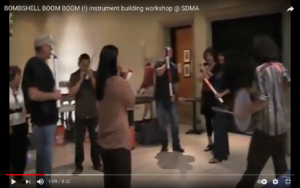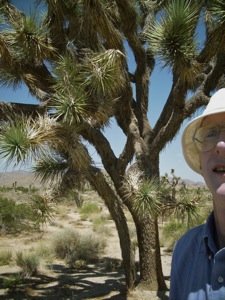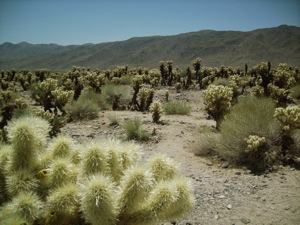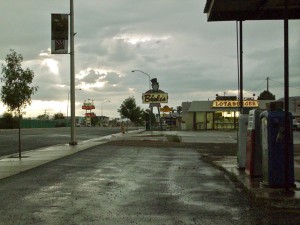This morning I took a side trip to El Malpais National Monument, which lies just to the south of Grants, New Mexico. I didn’t really go to see the lava flows which give El Malpais (“the badlands”) its name; I went to walk in the high desert, take some photographs, and maybe see some birds. I managed to do all three. You’ll have to take my word for the walking, but here’s a photograph of the lava flows (they’re the dark areas down in the valley), as seen from the top of Sandstone Bluffs:
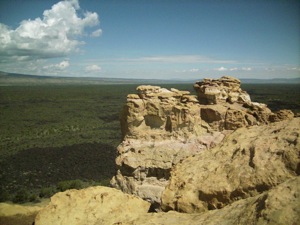
And I saw some birds, too: Black-Chinned Hummingbirds, Scott’s Orioles, Pinyon Jays, Cassin’s Kingbirds, and several other desert-dwelling birds that I had never seen before.
While I sat at the ranger station admiring the hummingbirds and orioles coming to the hummingbird feeder, I heard thunder in the distance. Not long after I started driving, it started raining. I drove through rain from Grants to Gallup. I stopped in Gallup to get lunch and gas, and while I was eating lunch there was a real downpour. I ran out to the car when the rain let up a little, and drove through streets that were several inches deep in muddy brown water. This is insane, I thought, but I was on a tight schedule, so I got on the freeway and drove slowly through the rain. Pretty soon it let up, but I drove through occasional light showers for most of the rest of the day.
I decided I didn’t want to spend any money in Arizona, because of the ridiculous immigration law that the state legislature passed. While I’m sure Arizona will never notice the loss of my paltry travel dollars, I felt better knowing that I had not bought any gas or food in the state. Unfortunately, Arizona is in such tough financial shape that they have closed all the highway rest areas, so somewhere around Flagstaff where there are trees, I found a place by the side of the road where I could pee.
I arrived in Needles, California, at about 7:30. When I opened the door of the car, the air was unbelievably hot. It was so hot and dry that my eyeballs kind of hurt; and every once in a while, a gust of hot wind coming off the desert would make it feel even hotter. According to the National Weather Service, at 6:56 p.m. it was 105 degrees; and last night, the low temperature was 90 degrees.
In spite of the heat, I walked the few blocks from the motel to downtown Needles. The air was so dry, I could feel the moisture being sucked out of my mouth and nose. Not much was happening in downtown Needles; the main activity seemed to be around the BNSF (Burlington Northern Santa Fe) railroad yards, where dozens of cars and pickup trucks were parked. A few people were out walking around, a few cars passed by, but mostly the town was empty. The cartoonist Charles Schulz, who drew the “Peanuts” cartoon, lived here for a few years when he was a child, and his biographer David Michaelis writes:
By day, the sun broiled the vast playa above the town — 120 degrees in the shade of a cottonwood tree was normal for Needles in summer. Most winter nights, the translucent air turned the dry gullies into such iceboxes that he [Schulz] could hear rocks cracking in the cold. In May and September the old wooden tinderbox of a schoolhouse was frequently shut to protect the children from heatstroke. Such little rain as fell came briefly and violently, blasting flash floods out of nowhere.
Needles, [Schulz] decided, was a “miserable place.”
I bought a copy of the Needles Desert Star, “Established in 1888, serving the community of Needles for more than a century.” I learned that the city attorney has been holding training sessions on Robert’s Rules of Order for the members of the city council and various boards; this seems a good plan, and I can think of several communities that should try this sort of thing. Tribal elders gave blessings in the Mohave language to a new park project being built with America Recovery and Reinvestment Act money. And city council members held a meeting to address the sale of the local hospital. In 1983, Charles Schulz’s “Peanuts” was syndicated in its two thousandth newspaper, in Needles, California (Michaelis, p. 531), but I did not find any comic strips at all today’s edition of the Needles Desert Star.

